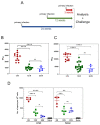Prolonged Protective Immunity Induced by Mild SARS-CoV-2 Infection of K18-hACE2 Mice
- PMID: 35455362
- PMCID: PMC9032525
- DOI: 10.3390/vaccines10040613
Prolonged Protective Immunity Induced by Mild SARS-CoV-2 Infection of K18-hACE2 Mice
Abstract
Longevity of the immune response following viral exposure is an essential aspect of SARS-CoV-2 infection. Mild SARS-CoV-2 infection of K18-hACE2 mice was implemented for evaluating the mounting and longevity of a specific memory immune response. We show that the infection of K18-hACE2 mice induced robust humoral and cellular immunity (systemic and local), which persisted for at least six months. Virus-specific T cells and neutralizing antibody titers decreased over time, yet their levels were sufficient to provide sterile immunity against lethal rechallenge six months post-primary infection. The study substantiates the role of naturally induced immunity against SARS-CoV-2 infection for preventing recurring morbidity.
Keywords: COVID-19; K18-hACE2 mice; SARS-CoV-2; mild infection.
Conflict of interest statement
The authors declare no conflict of interest.
Figures


References
LinkOut - more resources
Full Text Sources
Molecular Biology Databases
Miscellaneous

